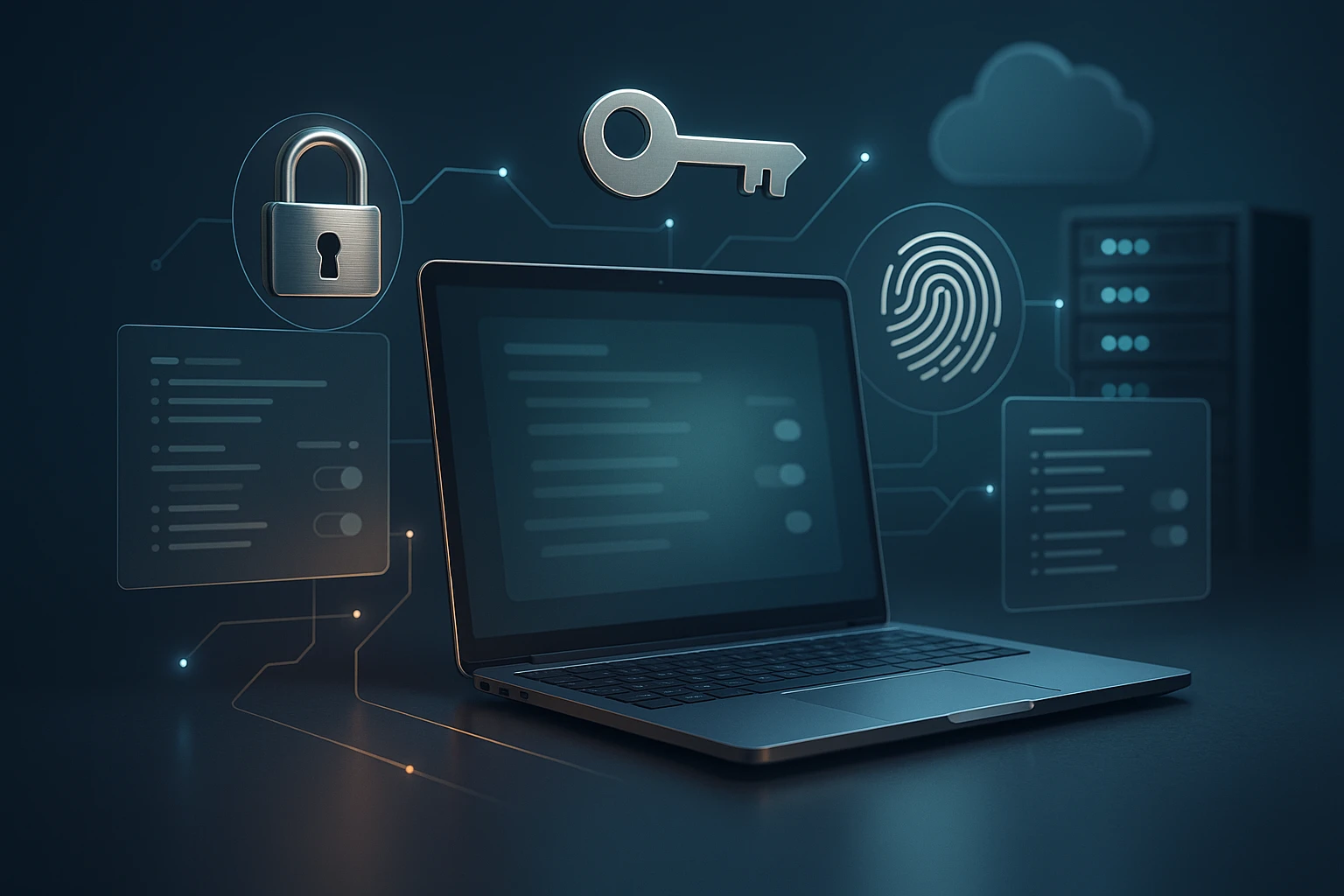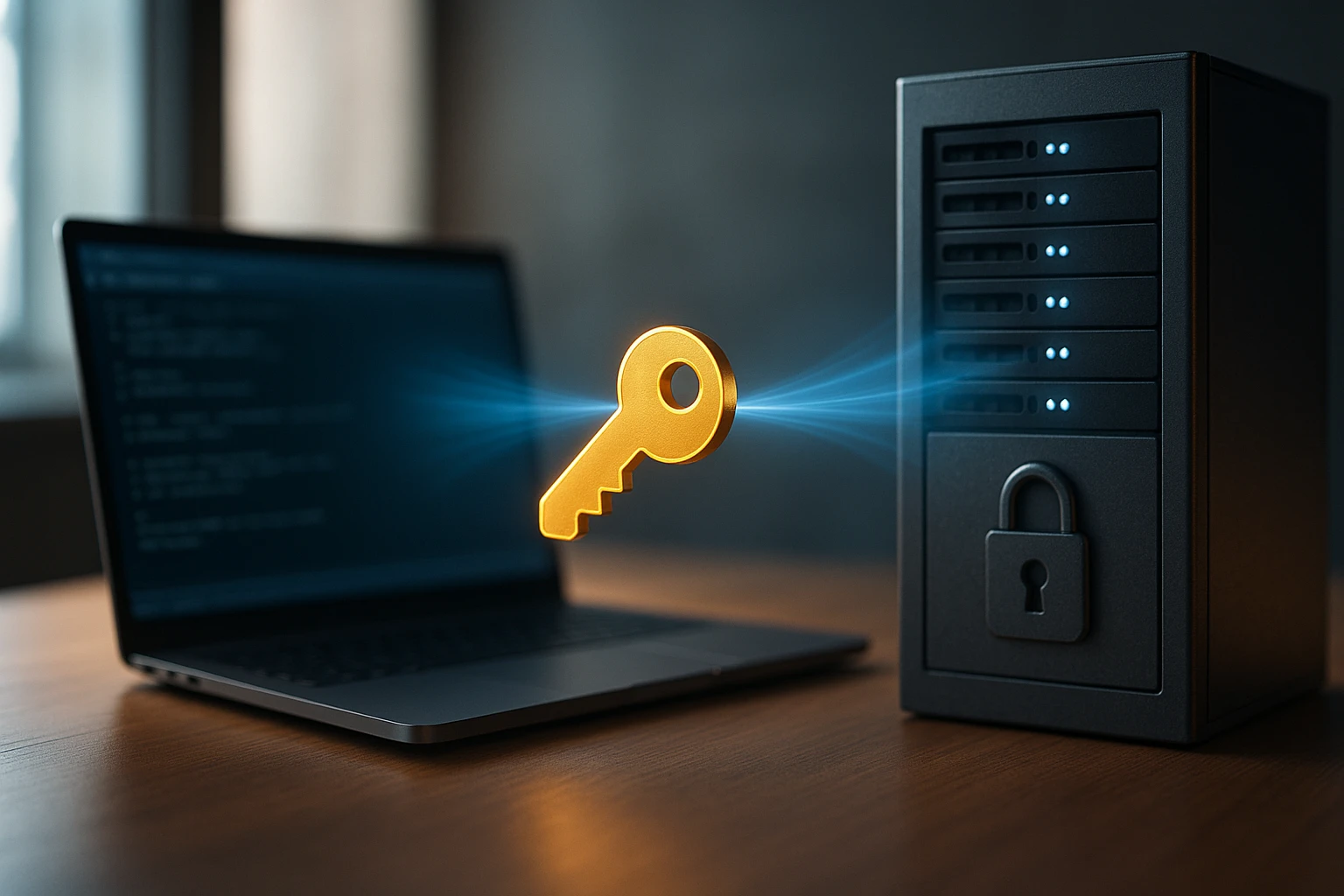Managing SSH Configuration Files for Security
Hands editing an SSH config file on laptop, showing secure options: PermitRootLogin no, PubkeyAuthentication yes, strict file permissions, commented notes for audit and compliance.

Sponsor message — This article is made possible by Dargslan.com, a publisher of practical, no-fluff IT & developer workbooks.
Why Dargslan.com?
If you prefer doing over endless theory, Dargslan’s titles are built for you. Every workbook focuses on skills you can apply the same day—server hardening, Linux one-liners, PowerShell for admins, Python automation, cloud basics, and more.
Managing SSH Configuration Files for Security
In today's interconnected digital landscape, securing remote access to servers and systems has become a fundamental concern for organizations and individuals alike. Every day, countless unauthorized access attempts target vulnerable systems, making robust security configurations not just recommended but absolutely essential. The configuration files that govern SSH (Secure Shell) connections serve as the first line of defense against these persistent threats, determining who can access your systems and under what conditions.
SSH configuration management encompasses the systematic approach to defining, implementing, and maintaining security parameters that control remote access to computing resources. This involves understanding multiple configuration layers, from system-wide settings to user-specific preferences, and implementing security best practices that balance accessibility with protection. Through proper configuration management, administrators can establish secure communication channels while maintaining operational efficiency.
Throughout this comprehensive guide, you'll discover practical strategies for optimizing SSH configuration files, understand the critical security parameters that demand attention, and learn how to implement layered security approaches that protect against common vulnerabilities. We'll explore both client-side and server-side configurations, examine real-world security scenarios, and provide actionable recommendations that can be implemented immediately to enhance your system's security posture.
Understanding SSH Configuration Architecture
The SSH configuration ecosystem operates through a hierarchical structure where multiple configuration files interact to determine final connection parameters. At the foundation lies the system-wide server configuration, typically located at /etc/ssh/sshd_config, which establishes baseline security policies for all users. This primary configuration file contains directives that govern authentication methods, encryption algorithms, connection timeouts, and access restrictions that apply universally across the system.
Client-side configurations follow a similar hierarchical pattern, with system-wide settings residing in /etc/ssh/ssh_config and user-specific preferences stored in ~/.ssh/config. This layered approach enables administrators to enforce organizational security standards while allowing individual users the flexibility to customize their connection preferences within permitted boundaries. Understanding this hierarchy proves essential when troubleshooting connection issues or implementing security policies, as settings in user-specific files can override system-wide configurations unless explicitly prevented.
"The most sophisticated security breach often exploits the simplest misconfiguration in SSH settings."
Configuration precedence follows a specific order where user-specific settings take priority over system-wide configurations, and command-line options override all file-based settings. This precedence model requires administrators to carefully consider where specific security directives should be implemented to ensure they cannot be circumvented by users with malicious intent or insufficient security awareness.
Critical Configuration File Locations
Proper security management begins with knowing exactly where configuration files reside and understanding their specific purposes. The primary server configuration file controls all incoming SSH connections and should be protected with strict file permissions. Backup copies of this file should be maintained before making any modifications, as syntax errors can lock administrators out of remote systems entirely.
| Configuration File | Location | Purpose | Recommended Permissions |
|---|---|---|---|
| Server Configuration | /etc/ssh/sshd_config | System-wide server settings | 644 (root:root) |
| Client System Configuration | /etc/ssh/ssh_config | Default client behavior | 644 (root:root) |
| User Client Configuration | ~/.ssh/config | User-specific preferences | 600 (user:user) |
| Host Keys | /etc/ssh/ssh_host_*_key | Server identity verification | 600 (root:root) |
| Authorized Keys | ~/.ssh/authorized_keys | Public key authentication | 600 (user:user) |
Beyond these primary configuration files, several supporting files play crucial roles in SSH security. The known_hosts file maintains fingerprints of previously connected servers, preventing man-in-the-middle attacks by alerting users when server identities change unexpectedly. The authorized_keys file contains public keys permitted to authenticate as specific users, forming the backbone of key-based authentication systems.
Essential Server Configuration Hardening
Securing the SSH server configuration requires implementing multiple defensive layers that collectively reduce attack surfaces and limit potential damage from successful breaches. The first critical step involves disabling root login entirely, forcing attackers to compromise a regular user account before attempting privilege escalation. This additional barrier significantly increases the difficulty of system compromise and provides additional logging opportunities to detect intrusion attempts.
Password authentication, while convenient, represents one of the weakest authentication methods available. Modern computing power enables rapid brute-force attacks against password-protected accounts, making key-based authentication essential for production environments. Disabling password authentication forces all users to employ cryptographic keys, which are exponentially more difficult to compromise through automated attacks.
🔒 Core Security Directives
- PermitRootLogin no - Prevents direct root access, requiring users to authenticate as regular accounts first
- PasswordAuthentication no - Disables password-based login, enforcing key-based authentication exclusively
- PubkeyAuthentication yes - Enables public key authentication as the primary access method
- PermitEmptyPasswords no - Prevents accounts without passwords from authenticating
- MaxAuthTries 3 - Limits authentication attempts before disconnection, slowing brute-force attacks
- LoginGraceTime 30 - Reduces the window for authentication, limiting exposure to slow attacks
- ClientAliveInterval 300 - Maintains connection health while detecting dead connections
- ClientAliveCountMax 2 - Terminates unresponsive sessions to free resources
"Security configurations should assume breach as inevitable and focus on limiting damage rather than preventing all intrusions."
Protocol version enforcement ensures that only modern, secure SSH versions can establish connections. While SSH protocol version 1 offered groundbreaking security in its time, numerous vulnerabilities have been discovered that make it unsuitable for contemporary use. Explicitly specifying Protocol 2 in the server configuration prevents fallback to older, compromised protocol versions.
Advanced Access Control Mechanisms
Granular access control extends beyond simple allow/deny decisions to implement sophisticated rules based on user identity, source location, and time-based restrictions. The AllowUsers and AllowGroups directives create whitelists of permitted accounts, ensuring that only explicitly authorized users can attempt authentication. This approach proves particularly valuable in environments where user accounts exist for purposes other than SSH access.
Complementing whitelist approaches, DenyUsers and DenyGroups directives provide blacklist functionality for explicitly blocking specific accounts. Combining both approaches enables sophisticated access policies where most users are denied by default, specific groups are permitted, and particular high-risk accounts are explicitly blocked regardless of group membership.
Network-based restrictions add another security layer by limiting SSH access to specific IP addresses or network ranges. The Match directive enables conditional configuration blocks that apply different security policies based on source addresses, user accounts, or other connection attributes. This capability allows administrators to implement stricter security requirements for connections originating from untrusted networks while maintaining convenience for internal access.
Cryptographic Algorithm Selection
The cryptographic algorithms employed by SSH directly impact both security strength and connection performance. Modern SSH implementations support numerous cipher suites, key exchange algorithms, and message authentication codes, but not all provide equivalent security. Older algorithms remain available primarily for backward compatibility but should be disabled in security-conscious environments to prevent downgrade attacks.
Cipher selection determines how session data is encrypted during transmission. Contemporary best practices recommend using only AEAD (Authenticated Encryption with Associated Data) ciphers that provide both confidentiality and integrity protection in a single operation. The ChaCha20-Poly1305 cipher offers excellent performance on systems without hardware AES acceleration, while AES-GCM provides superior speed on modern processors with dedicated cryptographic instructions.
| Algorithm Type | Recommended Options | Security Level | Performance Impact |
|---|---|---|---|
| Key Exchange | curve25519-sha256, diffie-hellman-group-exchange-sha256 | High | Low |
| Host Key | ssh-ed25519, rsa-sha2-512, rsa-sha2-256 | High | Minimal |
| Cipher | chacha20-poly1305@openssh.com, aes256-gcm@openssh.com | High | Low-Medium |
| MAC | hmac-sha2-512-etm@openssh.com, hmac-sha2-256-etm@openssh.com | High | Low |
| Compression | none, zlib@openssh.com (post-auth only) | N/A | Variable |
"The strength of your encryption is only as good as the weakest algorithm you permit."
Key exchange algorithms establish the shared secret used to encrypt the SSH session. Elliptic curve methods like Curve25519 provide equivalent security to much larger traditional keys while requiring significantly less computational overhead. Disabling older key exchange methods based on SHA-1 prevents potential vulnerabilities from cryptographic weaknesses in deprecated hash functions.
🔐 Implementing Algorithm Restrictions
- Disable weak ciphers - Remove 3DES, Blowfish, and CAST128 from available options
- Prefer AEAD ciphers - Prioritize algorithms providing authenticated encryption
- Use strong key exchange - Implement elliptic curve and large group Diffie-Hellman methods
- Enforce modern host keys - Generate and use Ed25519 or large RSA keys
- Select secure MACs - Choose encrypt-then-MAC variants with SHA-2 hashing
Message Authentication Code selection ensures data integrity by preventing tampering during transmission. The encrypt-then-MAC (ETM) variants provide stronger security guarantees by authenticating the encrypted data rather than plaintext, preventing certain classes of cryptographic attacks. Configuring SSH to exclusively use ETM variants eliminates potential vulnerabilities in older MAC implementations.
Authentication Method Configuration
Authentication methods determine how users prove their identity when establishing SSH connections. While multiple authentication mechanisms exist, significant security differences exist between them. Public key authentication provides the strongest security by leveraging asymmetric cryptography where private keys never traverse the network. This approach eliminates password interception risks and enables centralized key management through authorized_keys files.
Implementing public key authentication requires generating key pairs, distributing public keys to target systems, and properly securing private keys on client systems. Modern key generation should use Ed25519 algorithm for optimal security and performance, though RSA keys with 4096-bit length provide acceptable alternatives for compatibility with older systems. The private key should be encrypted with a strong passphrase, adding an additional security layer if the key file is compromised.
Multi-Factor Authentication Implementation
Multi-factor authentication significantly enhances security by requiring multiple independent verification methods. Combining something you have (private key) with something you know (passphrase or OTP) creates a robust authentication system resistant to single-factor compromise. SSH supports various multi-factor approaches through PAM (Pluggable Authentication Modules) integration and native authentication method chaining.
Time-based One-Time Password (TOTP) systems like Google Authenticator provide practical second-factor authentication that doesn't require network connectivity or specialized hardware. Integration involves installing the appropriate PAM module, configuring SSH to require both public key and keyboard-interactive authentication, and enrolling users with their TOTP applications. This configuration ensures that even if an attacker obtains a user's private key, they cannot authenticate without also possessing the user's TOTP device.
"Authentication should never rely on a single factor, regardless of how strong that factor appears."
🛡️ Authentication Best Practices
- Mandatory key-based authentication - Disable password authentication entirely in production environments
- Key passphrase enforcement - Require private keys to be encrypted with strong passphrases
- Regular key rotation - Implement policies requiring periodic generation of new key pairs
- Certificate-based authentication - Deploy SSH certificates for centralized key management at scale
- Hardware token integration - Utilize FIDO2/U2F devices for phishing-resistant authentication
Certificate-based authentication represents an advanced approach particularly valuable in large environments. Rather than distributing individual public keys to each server, administrators can issue short-lived certificates signed by a trusted Certificate Authority. Servers configured to trust this CA automatically accept any valid certificate, simplifying key management and enabling fine-grained access control through certificate extensions.
Client Configuration Security
Client-side SSH configuration receives less attention than server hardening but plays an equally important role in maintaining security. The client configuration determines which servers users can connect to, what authentication methods are attempted, and how host verification is performed. Properly configured clients protect users from connecting to malicious servers masquerading as legitimate systems.
Host key verification prevents man-in-the-middle attacks by ensuring the server you're connecting to is actually the intended destination. The StrictHostKeyChecking directive controls how SSH handles unknown or changed host keys. Setting this to "yes" forces SSH to reject connections when host keys don't match known values, providing strong protection against interception attempts at the cost of requiring manual intervention when legitimate key changes occur.
Connection Security Parameters
Client configurations should mirror server security requirements by specifying acceptable algorithms and authentication methods. Explicitly defining preferred ciphers, key exchange algorithms, and MACs in the client configuration ensures that connections use strong cryptography even when connecting to servers that still support weaker options. This approach protects against downgrade attacks where adversaries force the use of compromised algorithms.
Connection timeouts and keep-alive settings impact both security and usability. Aggressive timeout values reduce the window for hijacking idle sessions but may disconnect users during legitimate periods of inactivity. The ServerAliveInterval and ServerAliveCountMax directives configure client-side connection monitoring, automatically terminating sessions that have lost connectivity rather than leaving them indefinitely open.
📝 Client Configuration Template
- Host-specific configurations - Define connection parameters for individual servers or server groups
- Identity file management - Specify which private keys to use for different destinations
- Proxy jump configuration - Establish secure paths through bastion hosts
- Connection multiplexing - Reuse existing connections for improved performance
- Local forwarding rules - Configure port forwarding for specific use cases
"Client security is often the weakest link in SSH deployments, yet it receives minimal attention during security reviews."
Connection multiplexing enables multiple SSH sessions to share a single network connection, improving performance and reducing authentication overhead. The ControlMaster and ControlPath directives configure this functionality, creating a socket file that subsequent connections can use. While convenient, multiplexing requires careful security consideration as compromising the control socket grants access to all multiplexed sessions.
Logging and Monitoring Configuration
Comprehensive logging provides visibility into SSH access patterns, authentication attempts, and potential security incidents. The LogLevel directive controls the verbosity of SSH logging, with values ranging from QUIET to DEBUG3. For security monitoring, VERBOSE level provides detailed information about authentication attempts and connection parameters without generating excessive debug output that complicates log analysis.
Effective log monitoring requires not just collecting logs but actively analyzing them for suspicious patterns. Failed authentication attempts from unusual source addresses, successful logins at unexpected times, or rapid connection attempts from distributed sources all indicate potential security incidents requiring investigation. Integrating SSH logs with centralized logging systems and security information and event management (SIEM) platforms enables automated alerting and correlation with other security events.
🔍 Critical Events to Monitor
- Authentication failures - Track failed login attempts, especially from unusual sources
- Successful authentications - Monitor who accesses systems and when
- Configuration changes - Alert on modifications to SSH configuration files
- Key file access - Track access to authorized_keys and host key files
- Privilege escalation - Monitor sudo usage following SSH authentication
Audit logging through PAM integration provides additional visibility into session activities beyond initial authentication. The pam_tty_audit module can record all commands executed during SSH sessions, creating detailed audit trails for compliance and incident investigation. While this level of monitoring raises privacy considerations, it proves invaluable in high-security environments where complete session accountability is required.
"Logs that aren't actively monitored provide only historical context during incident response, not the real-time awareness needed for prevention."
File Permission and Ownership Security
Incorrect file permissions on SSH configuration files and keys represent a common security vulnerability that can completely undermine other security measures. SSH deliberately refuses to use configuration files and keys with overly permissive permissions, recognizing that world-readable private keys or configuration files modifiable by unprivileged users create unacceptable security risks.
The SSH server configuration file should be owned by root with permissions set to 644, allowing all users to read the configuration but restricting modifications to the system administrator. Private host keys require even stricter protection with 600 permissions, ensuring only root can read or modify these critical files. Public host keys can have more relaxed 644 permissions as they contain no sensitive information.
User Directory Security
User home directories and their .ssh subdirectories require careful permission management. The home directory should not be world-writable, as this would allow other users to replace the .ssh directory entirely. The .ssh directory itself must have 700 permissions, preventing other users from reading or modifying its contents. This protection ensures that only the directory owner can access their private keys and configuration files.
The authorized_keys file determines which public keys can authenticate as a specific user and must have 600 permissions. More permissive settings would allow other users to add their own keys, effectively granting them the ability to authenticate as the target user. Similarly, private key files must have 600 permissions, and SSH will refuse to use keys that are readable by other users.
Advanced Security Features
Modern SSH implementations include sophisticated security features that go beyond basic authentication and encryption. The Match directive enables conditional configuration blocks that apply different security policies based on user, group, host, or address criteria. This capability allows administrators to implement graduated security policies where trusted internal users receive more permissive configurations while external access faces stricter requirements.
Port forwarding and tunneling capabilities make SSH incredibly versatile but also introduce security risks if not properly controlled. The AllowTcpForwarding, AllowStreamLocalForwarding, and GatewayPorts directives control various forwarding mechanisms. Disabling unnecessary forwarding types reduces attack surface and prevents users from bypassing network security controls by tunneling through SSH connections.
🚀 Advanced Configuration Techniques
- Chroot jail implementation - Restrict SFTP users to specific directory trees
- Command restriction - Limit authenticated users to specific commands via forced commands
- Environment variable control - Restrict which environment variables clients can set
- Session type limitations - Disable PTY allocation for automated accounts
- Subsystem restrictions - Control access to SFTP and other SSH subsystems
Chroot SFTP configurations provide secure file transfer capabilities while preventing users from accessing the broader filesystem. The ChrootDirectory directive combined with the internal SFTP server creates an isolated environment where users can only access files within their designated directory tree. This approach proves particularly valuable for providing external partners with file transfer capabilities without granting broader system access.
"Advanced SSH features should be enabled only when specifically required, with each capability carefully evaluated for security implications."
Configuration Testing and Validation
Changes to SSH configuration files should never be applied directly to production systems without thorough testing. The sshd -t command validates configuration syntax without actually starting the SSH daemon, catching configuration errors that would otherwise lock administrators out of remote systems. This validation should be performed automatically as part of configuration management workflows to prevent deployment of broken configurations.
Beyond syntax validation, functional testing ensures that security policies work as intended. This involves attempting connections with various authentication methods, from different source addresses, and as different users to verify that access controls function correctly. Automated testing frameworks can systematically verify that security requirements are met, preventing configuration drift that gradually weakens security over time.
Configuration Management and Version Control
SSH configuration files should be managed through version control systems that track changes, maintain history, and enable rollback when problems occur. This approach provides accountability by recording who made changes and why, facilitates review processes before changes are deployed, and ensures that configurations can be quickly restored if modifications cause problems. Integration with configuration management platforms like Ansible, Puppet, or Chef enables consistent deployment across large server fleets.
Documentation of configuration decisions proves invaluable for maintaining security over time. Each non-default setting should be accompanied by comments explaining its purpose, the threat it addresses, and any compatibility considerations. This documentation helps future administrators understand existing configurations and make informed decisions about modifications without inadvertently weakening security.
Incident Response Preparation
Despite best efforts at prevention, security incidents involving SSH access do occur. Preparation for these scenarios includes maintaining offline backups of configuration files, documenting emergency access procedures, and establishing processes for rapid key revocation. The ability to quickly disable compromised accounts or keys significantly limits damage from successful attacks.
Emergency access mechanisms provide a safety net when primary SSH access fails or becomes compromised. This might include console access through datacenter infrastructure, out-of-band management interfaces, or secondary SSH configurations listening on non-standard ports with different authentication requirements. These emergency access methods must themselves be secured to prevent them from becoming attack vectors.
Compliance and Regulatory Considerations
Many industries face regulatory requirements that impact SSH configuration. PCI DSS, HIPAA, SOC 2, and other compliance frameworks often mandate specific authentication methods, encryption strengths, and logging requirements. Understanding these requirements ensures that SSH configurations not only provide security but also satisfy audit requirements. Regular compliance assessments verify that configurations remain aligned with regulatory expectations as requirements evolve.
Documentation of security controls implemented through SSH configuration supports compliance efforts by providing auditors with evidence of security measures. This documentation should map specific configuration directives to compliance requirements, explain how the configuration satisfies security objectives, and demonstrate that controls are consistently applied across all systems in scope.
Regular Security Reviews
SSH security is not a one-time configuration task but an ongoing process requiring regular review and updates. Cryptographic best practices evolve as new attacks are discovered and computational capabilities increase. Configuration reviews should occur at least quarterly, examining current settings against contemporary security recommendations and identifying areas for improvement.
Automated security scanning tools can identify common SSH configuration weaknesses, but human review remains essential for understanding context and making nuanced security decisions. Reviews should consider not just the technical configuration but also how SSH access patterns align with business requirements, whether access controls remain appropriate as organizational needs change, and if logging provides adequate visibility into system access.
What is the most critical SSH configuration change for immediate security improvement?
Disabling password authentication and enforcing key-based authentication provides the most significant immediate security improvement. This single change eliminates the vast majority of automated brute-force attacks that target SSH services. Implement this by setting PasswordAuthentication no in sshd_config, but ensure users have properly configured key-based authentication first to avoid locking everyone out.
How often should SSH host keys be rotated?
SSH host keys should be rotated when compromise is suspected, when systems are decommissioned and repurposed, or during major security incidents. Unlike user keys, routine rotation of host keys creates operational challenges as all clients must update their known_hosts files. Focus instead on protecting host keys through proper file permissions and monitoring for unauthorized access to key files.
Should I change the default SSH port from 22 to improve security?
Changing the SSH port reduces noise from automated scanning but provides minimal actual security benefit against determined attackers. Port scanning is trivial, and security should not rely on obscurity. Focus instead on strong authentication, proper access controls, and monitoring. If you do change ports, ensure firewall rules are updated accordingly and document the change clearly to prevent operational issues.
What's the difference between authorized_keys and known_hosts files?
The authorized_keys file contains public keys that are permitted to authenticate to a specific user account on a server. The known_hosts file contains fingerprints of server host keys that a client has previously connected to, protecting against man-in-the-middle attacks. Authorized_keys controls who can access your system, while known_hosts helps verify you're connecting to legitimate servers.
How can I allow SSH access only from specific IP addresses?
Implement IP-based access control using the Match Address directive in sshd_config to apply specific configurations to connections from designated IP ranges. Alternatively, use firewall rules to restrict SSH port access at the network level. Combining both approaches provides defense in depth. Remember that IP-based restrictions can cause problems for users with dynamic IPs or those accessing from multiple locations.
What logging level should I use for SSH in production?
Set LogLevel VERBOSE for production SSH servers to capture detailed authentication information without generating excessive debug output. This level logs all authentication attempts, connection sources, and key fingerprints used, providing essential data for security monitoring and incident investigation. More verbose levels like DEBUG should be used only temporarily when troubleshooting specific issues.
How do I implement multi-factor authentication with SSH?
Multi-factor authentication requires combining SSH's native public key authentication with additional factors through PAM modules. Install and configure google-authenticator PAM module for TOTP-based second factor, then modify sshd_config to set AuthenticationMethods publickey,keyboard-interactive. Each user must enroll their TOTP device before this configuration will allow them to authenticate.
What are the security implications of SSH agent forwarding?
SSH agent forwarding allows your authentication credentials to be used on remote systems, creating security risks if those systems are compromised. Attackers with root access on intermediate systems can hijack forwarded agent connections to authenticate as you to other systems. Use agent forwarding only when necessary and consider using ProxyJump instead, which doesn't forward credentials to intermediate hosts.




